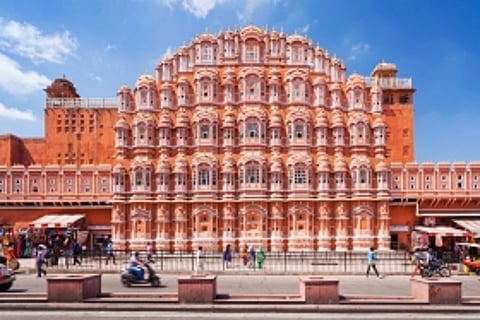Why the ‘palace of winds’ Hawa Mahal should be on top of your Jaipur itinerary
Jaipur is known for many things, it’s vibrant culture, the stunning monuments and picturesque natural beauty. Yet, the Hawa Mahal or ‘Palace of Winds’ has to be one of the most iconic monuments in the city. No matter how many days and how much time you spend in the city, the honeycomb monument still remains one of the most magnificent piece of architecture.
The Architecture
The Hawa Mahal palace was built in 1799 by Maharana Sawai Pratap Singh. It is made out of red sandstone in a shape that looks distinctly reminiscent of the Egyptian pyramids. The small windows are arranged so that the structure of the palace represents that of a honeycomb.
The palace of winds could so well also be called the palace of windows because Hawa Mahal has exactly 953 small windows which are traditionally called ‘Jharonkha’. The main attraction of the palace is its back exterior with the windows and the interior zenana. Because of its simple beauty people often confuse the honeycomb to be the front of the palace, but the structure was merely meant to be stood in.
The Story
The Hawa Mahal palace is said to have been inspired by the Khetri Mahal, which had huge windows and arches to let optimum air in the compound which happened to be located in a desert. People often misconstrue the flow of wind to be the reason why this palace was built. Sawai Pratap Singh got the Hawa mahal constructed not to facilitate an optimum airflow but to provide the royal and rajput women with an opportunity to observe the streets and the market without being seen themselves.
The idea was to create a structure which would extend to the zenana- the chambers of royal women, allowing women a passage to the Hawa Mahal through which they could observe the markets. The jharonkhas or small windows were also decorated with lattice work to make sure that the women could enjoy the view without being seen. The parda system was at its peak in the time hence it was the only way for royal women to involve themselves in the day to day life.
What Else
Hawan Mahal is one of the most stunning architectural monuments you will lay your eyes upon. The many windows, the stories and the pink of the sandstone make it an appealing sight. Located at Badi Chowpal the Hawa mahal has its very own market where you can find some of the most beautiful handicraft and Rajasthani apparels. So if you want to indulge in a light shopping and sightseeing experience, head to Hawa Mahal and spend a day living like the royalty.
To get all the latest content, download our mobile application. Available for both iOS & Android devices.

